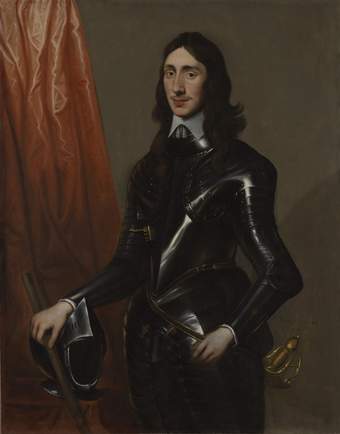
Fig.1
Edward Bower active 1629–c.1667
Sir John Drake 1646
Tate
T00500
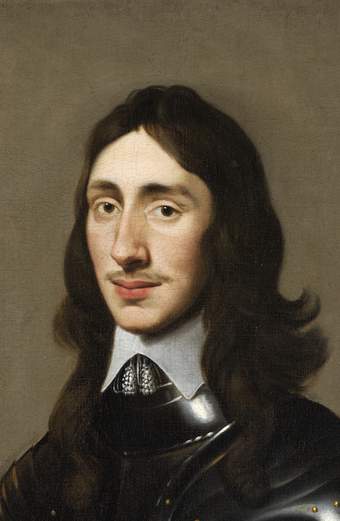
Fig.2
Detail of the head of Sir John Drake 1646

Fig.3
Detail of the sword hilt, signature and background
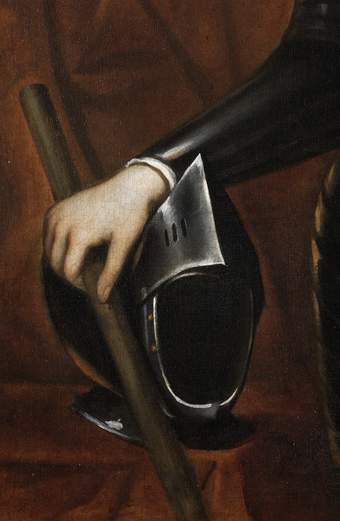
Fig.4
Detail of the right arm, staff and helmet
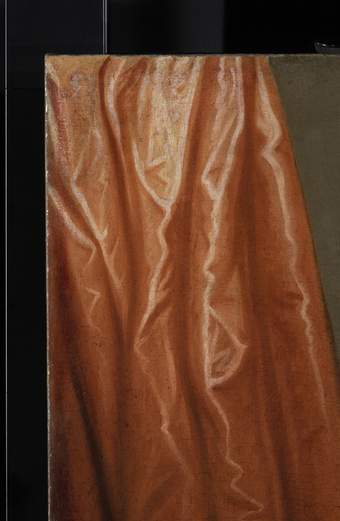
Fig.5
Detail of the red curtain in the background
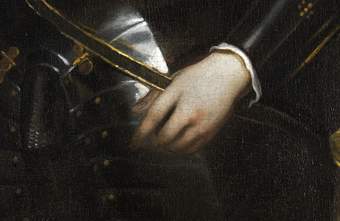
Fig.6
Detail of the left hand and armour
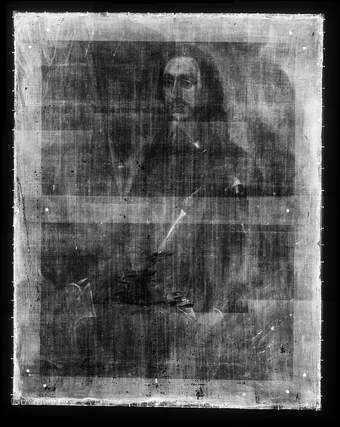
Fig.7
X-radiograph of Sir John Drake 1646
This painting is in oil paint on canvas measuring 1244 x 981 mm (figs.1–6). The linen canvas support has a thread count of 11 x 11 threads per square centimetre. It has marked cusping on all four edges, indicating that there has been no trimming of the image, although a slender strip of each original tacking margin is now incorporated into the picture plane (fig.7).1 The lining of wax-resin adhesive on canvas and the stretcher are modern.
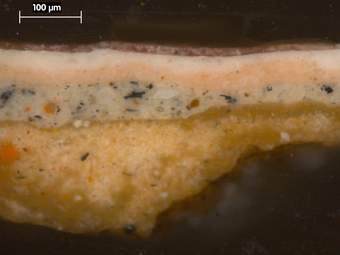
Fig.8
Cross section taken from the highlight of the red curtain, at the top right corner, and photographed at x225 magnification. From the bottom of the sample upwards: off-white ground; opaque grey priming; opaque pink body paint of curtain; white highlight of curtain, possibly applied wet-in-wet with the pink paint beneath it; pinkish red, semi-translucent glaze of curtain; varnish
The ground is warm off-white in colour and measures between 80 and 220 microns in thickness. It is rich in marine chalk and also contains lead white, black, fine opaque red and bright orange particles (fig.8).2 The priming is opaque grey, its thickness varying between 30 and 80 microns; it contains lead white, chalk and a range of black, opaque red, yellow, orange particles and translucent brown.

Fig.9
Infrared reflectogram
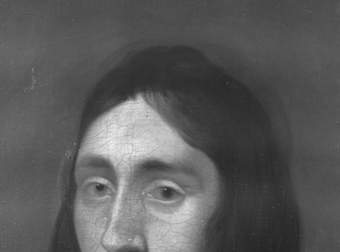
Fig.10
Infrared reflectogram detail of Sir John Drake’s head
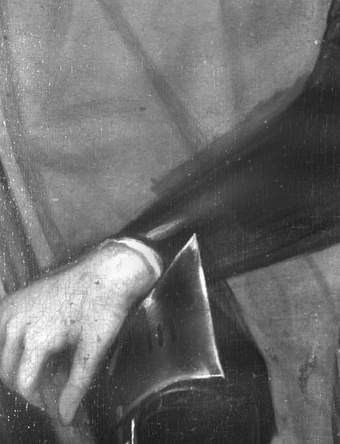
Fig.11
Infrared reflectogram detail of Sir John Drake’s right forearm and helmet
No underdrawing was detectable with infrared reflectography, but a number of alterations to the composition were revealed (figs.9–11). The head has been moved down, the sitter’s right shoulder was dropped slightly and his forearm widened whilst his left arm has been reduced slightly in width and moved in towards the body. Likewise, the half of the visor in shadow on the helmet has been extended over the red curtain. The sword hilt has also been altered but this is equally obvious to the unaided eye. There may also be some adjustment to the position of the baton held in the sitter’s proper right hand. No surface evidence confirms this and the general lack of contrast in the X-radiograph coupled with what may be marks from past lining treatment (involving applied adhesive and scraping) creates significant doubt (fig.7).
Surface examination of the painting reveals little overlapping of forms and indicates a clear reserve being left for the figure and curtain. The background paint was brought up to the edges of the figure and in localised areas was used to define edges of the armour. This seems to have been a final adjustment and there is now a colour discrepancy between these last paint additions and the rest of the background colour. The paint is well bound and was softly blended wet-in-wet on the painting.
The background grey is composed of varying amounts of lead white, charcoal black, Cologne earth, yellow earth colour, vermilion and red lake. The tones were mixed on the palette and applied wet-in-wet in one layer to the grey priming. Where the outline of the figure was adjusted by the artist, more grey paint was applied to define the new contour; the passage of time has produced some difference of colour in these phases of painting. Again with the passage of time, the background paint has become peppered with tiny paint losses caused by the formation of lead soap aggregates within the paint film, which have later broken through it. Viewed microscopically these aggregates appear orange coloured from the formation of red lead within most of the aggregates. The sword hilt has been affected similarly.
The curtain was constructed in two phases, the first to establish the folds with opaque tones of off-white, pink and reddish brown, followed by red scumbles and glazes containing varying amounts of lead white, aluminium-based red lake, red and yellow earth pigments, black, chalk and Cologne earth. There has been some fading of the red lake.
A distinctive feature is the painting of the highlights on the metal armour. Each highlight is defined in three tones of paint, starting with dark grey composed of black and lead white. On top of this is a smaller area of half-tone, composed of charcoal black; lead white; glassy particles which are probably smalt; what may be an artificial copper blue; and red lake. The final highlight also contains blue in a lead white matrix. A similar system was used for the metal sword hilt, with yellow ochre and lead tin yellow the main pigments.
All the tones of the face were produced with paint applied wet-in-wet; little if any use was made of the grey priming for half-tones. Besides lead white, pigments in the face include red lake, black and red earth or vermilion. No blue appears to be present.
September 2020
